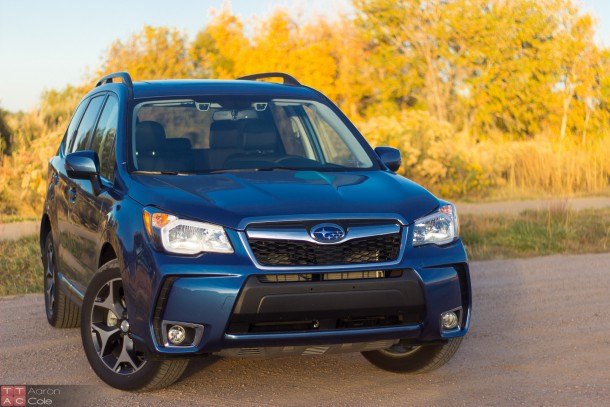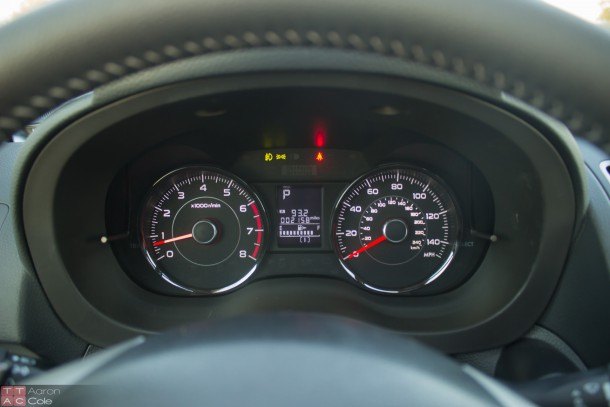2016 Subaru Forester XT Review - More Isn't Always More

2016 Subaru Forester XT
According to my nephew and me: If one is good then 100 is a good place to start.
My nephew is 11. I’m 33. Hopefully his gene pool is deeper than mine. But excess is extra good in my life. I appreciate a larger-than-I-need TV most nights and not one, but two, cheeseburgers in my value meals sometimes. If a Forester is good then a turbo Forester must be great according to my juvenile definition of the world.
Already one of the best crossovers on the market, the Forester actually benefits from Subaru’s glacial powertrain pace: flat-four up front, all-wheel drive underneath — and they’ll check back sometime during the next decade. The naturally aspirated, older 2.5-liter flat four does work in pedestrian Foresters; its 170 horsepower is competent like gas station coffee. Force feeding 80 more ponies — to a total of 250 for the turbo XT — should make the Forester better. It could, right?
I’ll put it this way: Does gas station creamer make gas station coffee better?
The turbo Forester certainly isn’t boring. It possess a rare quality of a car that pushes you back into forgettable seats and begs questions such as: “Wait. What car am I in again?” For the difference between what’s expected and what’s received, the Forester wins the Susan Boyle Surprise Award this year. (The same could be said for a Dodge Omni GLH.)
This year, calling the new Fozzy a “new Forester” could be an oxymoron. This year’s improvements include a telematics Starlink system to call for help if you find a ditch — and that’s it.
Exterior
The front of the Forester XT is decidedly tamer than what I expected for the turbocharged model. Despite sporting an intercooler and forced induction over the base model, the hood is the same this time around — no scoop.
The lone visual cue that this car may be different than the naturally aspirated model is the lower front fascia. A black chin strap on the Forester XT is the only indicator that this car may possibly be different.
The front’s bulbous lower doesn’t seem to match the upper half, and I’m inclined to call it Toyota-esque. Nonetheless, the Forester’s rear end doesn’t appear to bring up the side, so we’ll call the whole car’s exterior execution “understated.”
The good news is that the Forester’s sheet metal doesn’t match its mettle. The 8.7 inches of ground clearance is still shockingly good and the low belt line serves its purpose inside — not out. At just around 180 inches long, the Forester sports roughly the same dimensions as every other CUV on the market — including the Volkswagen Tiguan. (Mark’s review of the Mitsubishi Outlander Sport has me seeing Tiguans everywhere, apparently.)
Interior
Similarly, the gray stitching around our black leather seating (standard on Touring models, and not available on other models) broke up the sea of black associated with Subaru interiors, but the seats were merely adequate — two hours in the car felt like a night on an army cot.
Even in the Touring XT model like our tester, which tops the Forester range, the car showed its budget roots. The smallish, black-and-white LCD screen tucked into the center of the instrument cluster — which displays gear, fuel and mileage — doesn’t get replaced regardless of whether you’re spending $23,000 or $40,000 for the car.
But the function of the interior comes alive when you start stuffing dogs, gear, people, bikes, kayaks, people, gear and more dogs inside. The Forester’s 34.4 cubes is roughly the same size as the Ford Escape’s (34.3) but smaller than the Honda CR-V’s (35.2) and Toyota Rav4’s (38.4). It also sports a wide rear cargo opening to use the space. Fold-flat, 60/40 split rear seats help when gear outweighs people and more people. With the seats down, the Forester expands to 74.7 cubic feet of space, more than the Escape (67.8), the CR-V (70.9), Mazda CX-5 (64.8) and Rav4 (73.4).
Notes worth mentioning:
Infotainment
That system has been extensively covered, and isn’t technically new, but it is worth pointing out that the 6.1-inch and 7-inch screens are different experiences. The 7-inch screen, fitted in our Forester XT, is the vastly superior model and — in my opinion — worth it even if it means stepping up to Premium and higher trims to get.
The Touring models get a 440-watt Harman/Kardon audio system that for a semi-premium sounds remarkably good. The Forester lets in a fair bit of wind and whistle at highway speeds so it’s worth turning up the tunes.
The StarLink navigation pinches, swipes and slides, and is the best system I’ve found outside of Apple CarPlay that doesn’t cost silly money.
Powertrain
Both feature similar suspension setups — McPhersons up front, double wishbones and coils in the back (the WRX inverted its struts this year to accommodate bigger wheels), and identical all-wheel drive systems when equipped with an automatic transmission. (The WRX can be had with a manual, which is a different system, whereas there’s no way to get a turbocharged Forester with a stick … yet.)
The Forester’s power isn’t what I’d call linear. The engine huffs for a couple ticks at the low end before the turbo spools up and delivers all the power in one satisfying rush. The CVT simulates gear steps, and will run the Forester up to its 6,000 rpm redline, but the boost runs out of ideas well before that.
Subaru doesn’t advertise 0-60 mph times for the Forester XT, but our clock consistently showed runs up to a-mile-a-minute in just over 6.5 seconds — regardless of drive mode selected. The runs from 20-60 mph were considerably quicker.
The WRX sheds 1.5 seconds off the 0-60 mph time (due partly to its 174-pound diet) but also because its power is more direct and quicker off the line. The Forester XT isn’t the Forester STI — at least not yet.
Drive
Instead, the Forester XT is a better option for the “every options ticked” kind of buyer. You know the kind; the person who actually orders Showtime on his cable package because it’s nice to “have the option.”
A base model Forester is more than capable of pulling out of a snow storm, up a canyon and into wintery hell, so much so that it should be on the Colorado state flag. But, admittedly, the base, older 2.5-liter flat-four won’t blow any doors off the line.
The Forester XT compensates for that power loss in a very respectable way. The fuel economy penalty is minimal (27 combined vs. 25 combined), although the XT drinks premium fuel.
But for $3,900 over the same model, the XT doesn’t present a better value in terms of capability or performance. The Forester is good enough.

More by Aaron Cole
Latest Car Reviews
Read moreLatest Product Reviews
Read moreRecent Comments
- Dartdude The global climate scam is a money and power grab. If you follow the money it will lead you to Demo contributors or global elitists. The government needs to go back to their original purpose and get out of the public sector.
- FreedMike Miami is a trip - it's probably the closest thing we have to Dubai in this country. If you are into Lambos and the like, definitely go - you'll see a show every night. These condos fit right in with the luxury-brand culture - I'm surprised there isn't a Louis Vuitton or Gucci building. I was in Miami Beach in January with my fiancee, and we shared a lovely lunch that consisted of three street tacos each, chips and salsa, and two sodas. Tab: $70.00, with tip. Great town, assuming you can afford to live there.
- Kjhkjlhkjhkljh kljhjkhjklhkjh Pay money to be inundated in Adverts for a car that breaks when you sneeze? no
- Laflamcs My wife got a new 500 Turbo in 2015. Black exterior with an incredible red leather interior and a stick! The glass sunroof was epic and it was just about the whole roof that seemed to roll back. Anyway, that little bugger was an absolute blast to drive. Loved being run hard and shifted fast. Despite its small exterior dimensions, one could pile a lot into it. She remember stocking up at COSTCO one time when a passerby in the parking lot looked at her full cart and asked "Will it all fit?" It did. We had wonderful times with that car and many travels. It was reliable in the years we owned it and had TONS of character lacking in most "sporty" car. Loved the Italian handling, steering, and shift action. We had to trade it in after our daughter came along in 2018 (too small for 3 vacationers). She traded it in for a Jeep Renegade Latitude 6 speed, in which we can still feel a bit of that Italian heritage in the aforementioned driving qualities. IIRC, the engine in this Abarth is the same as in our Renegade. We still talk about that little 500..........
- Rochester If I could actually afford an Aston Martin, I would absolutely consider living in an Aston themed condo.




























































Comments
Join the conversation
Aside from more passing power w/o hair trigger throttle , the 2014 XT's WRX-like suspension, rather stiff on small stuff, eliminates pogo over speed bumps and potholes (huge improvement over '09 series XT). Granted, seats are hard and rear cargo light's weak. Still, Forester gets you there on pretty much any road, especially with true all weather tires (if you gotta drive on icy roads ditch those stock Bridgestones). As for lack of hood scoop, it's now under hood: You get the functionality without displaying boy-racer potential. FYI the '15 Outback 3.6R went to a CVT and lost its center diff as well.
So I had a regular 2012 Forester Limited and now a 2014 Forester XT for two years already. All the reviews I read were enthusiastic. This is the first disparaging review I read, and I disagree. I drove BMW-s for 10 years, and I know, I don't have the same luxury but I don't regret my purchase. Somebody mentioned Colorado, but know that the Washington State is a Subbie country... .